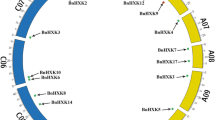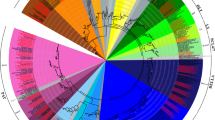Abstract
Encoding a WD40 protein,Arabidopsis thaliana TRANSPARENT TESTA GLABRA1 (AtTTG1) regulates trichome and root hair differentiation as well as flavonoids and seed mucilage deposition in plants. Here, twoBrassica napus TTG1 (BnTTG1) genes were isolated, and Southern hybridization also generated only two bands. The 1511-bpBnTTG1-1 and the 1555-bpBnTTG1-2 both have one intron, and show alternative sites for transcription start, polyadenylation and intron right border splicing. EST and GSS tags suggested thatBnTTG1-1 was derived from B. rapa, whileBnTTG1-2 from B. oleracea. Evidence implies that TTG1 was possibly triplicated in Brassiceae, but some triplicated members were lost soon, which might involve fragmental rearrangements.BnTTG1-1 shares 88.7% genomic and 95.7% mRNA identities withBnTTG1-2. Deduced BnTTG1-1 and BnTTG1-2 proteins both are 337 aa, differed only by substitution of a similar residue. They resemble AtTTG1 in WD40 domain and all conserved motifs. TTG1 / AN11-type WD40 proteins are extremely conserved even across kingdoms. Homological and structural characterizations identifiedBnTTG1-1 andBnTTG1-2 to be orthologs of AtTTG1. Several non-coding motifs are conserved between AtTTG1 and BnTTG1. BnTTG1 coding regions tend to evolve high GC contents through T/A→C/G substitutions especially T→C transition, butAtTTG1 shows opposite base preference.BnTTG1 genes also evolve a GA-stretch in the leader sequence. RT-PCR detected complementation in organ-specificity betweenBnTTG1-1 andBnTTG1-2.BnTTG1-2 is more like AtTTG1 and is expressed in all major organs.BnTTG1-1 is more organ-specific with lower expression in seed and root, possibly withdrawing from regulating seed coat pigment /mucilage deposition and root hair formation.
Similar content being viewed by others
References
Altschul SF, Madden TL, Schaffer AA, Zhang J, Zhang Z, Miller W and Lipman DJ (1997) Gapped BLAST and PSI-BLAST: a new generation of protein database search programs. Nucleic Acids Res. 25: 3389–3402.
Blom N, Sicheritz-Ponten T, Gupta R, Gammeltoft S and Brunak S (2004) Prediction of post-translational glycosylation and phosphorylation of proteins from the amino acid sequence. Proteomics 4: 1633–1649.
Broun P (2005) Transcriptional control of flavonoid biosynthesis: a complex network of conserved regulators involved in multiple aspects of differentiation inArabidopsis. Curr. Opin. Plant Biol. 8: 272–279.
Dellaporta SL, Wood J and Hicks JB (1983) A plant DNA minipreparation: version II. Plant Mol. Biol. Reptr. 1: 19–21.
de Vetten N, Quattrocchio F, Mol J and Koes R (1997) Thean11 locus controlling flower pigmentation in petunia encodes a novel WD-repeat protein conserved in yeast, plants, and animals. Genes Dev. 11: 1422–1434.
Galway M, Masucci J, Lloyd A, Walbot V, Davis R and Schiefelbein J (1994) TheTTG gene is required to specify epidermal cell fate and cell patterning in theArabidopsis root. Dev. Biol. 166: 740–754.
Geourjon C and Deléage G (1995) SOPMA Significant improvement in protein secondary structure prediction by consensus prediction from multiple alignments. Comput. Appl. Biosci. 11: 681–684.
Heneen WK and Brismar K (2001) Maternal and embryonal control of seed colour by differentBrassica alboglabra chromosomes. Plant Breed. 120: 325–329.
Humphries JA, Walker AR, Timmis JN and Orford SJ (2004) Two WD-repeat genes from cotton are functional homologues of theArabidopsis thalianaTRANSPARENT TESTA GLABRA1 (TTG1) gene. Plant Mol. Biol. 57: 67–81.
Jaakola L, Pirttilä AM, Halonen M and Hohtola A (2001) Isolation of high quality RNA from bilberry (Vaccinium myrtillus L.) fruit. Mol. Biotechnol. 19: 201–203.
Lee MM and Schiefelbein J (2001) Developmentally distinctMYB genes encode functionally equivalent proteins inArabidopsis. Development 128: 1539–1546.
Lockton S and Gaut BS (2005) Plant conserved noncoding sequences and paralogue evolution. Trends Genet. 21: 60–65.
Lukens L, Quijada P, Udall J, Pires JC, Schranz ME and Osborn TC (2004) Genome redundancy and plasticity within ancient and recentBrassica crop species. Biol. J. Linnean Soc. 82: 665–674.
Lysak MA, Koch MA, Pecinka A and Schubert I (2005) Chromosome triplication found across the tribeBrassiceae. Genome Res. 15: 516–525.
Marchler-Bauer A and Bryant SH (2004) CD-Search: protein domain annotations on the fly. Nucleic Acids Res. 32: W327–331.
Morita Y, Saitoh M, Hoshino A, Nitasaka E and Iida S (2006) Isolation of cDNAs for R2R3-MYB, bHLH, and WDR transcriptional regulators and identification ofc andca mutations conferring white flowers in the Japanese morning glory. Plant Cell Physiol. 4: 457–470.
Nissen RM, Amsterdam A and Hopkins N (2006) A zebrafish screen for craniofacial mutants identifieswdr68 as a highly conserved gene required for endothelin-1 expression. BMC Dev. Biol. 6: 28.
Rahman MH, Joersbo M and Poulsen MH (2001) Development of yellow-seededBrassica napus of double low quality. Plant Breed. 120: 473–478.
Ramsay NA and Glover BJ (2005) MYB-bHLH-WD40 protein complex and the evolution of cellular diversity. Trends Plant Sci. 10: 63–70.
Sambrook J and Russell DW (2001)Molecular cloning: a laboratory manual. Cold Spring Harbor Laboratory Press, New York.
Smith TF, Gaitatzes C, Saxena K and Neer EJ (1999) The WD repeat: a common architecture for diverse functions. Trends Biochem. Sci. 24: 181–185.
Sompornpailin K, Makita Y, Yamazaki M and Saito K (2002) A WD-repeat-containing putative regulatory protein in anthocyanin biosynthesis inPerilla frutescens. Plant Mol. Biol. 50: 485–495.
Springob K, Nakajima J, Yamazaki M and Saito K (2003) Recent advances in the biosynthesis and accumulation of anthocyanins. Nat. Prod. Rep. 20: 288–303.
Town CD, Cheung F, Maiti R, Crabtree J, Haas BJ, Wortman JR, Hine EE, Althoff R, Arbogast TS, Tallon LJ, Vigouroux M, Trick M and Bancroft I (2006) Comparative genomics ofBrassica oleracea andArabidopsis thaliana reveal gene loss, fragmentation, and dispersal after polyploidy. Plant Cell 18: 1348–1359.
van Nocker S and Ludwig P (2003) The WD-repeat protein superfamily inArabidopsis: conservation and divergence in structure and function. BMC Genomics 4: 50.
Walker A, Davison P, Bolognesi-Winfield A, James C, Srinivasan N, Blundell T, Esch J, Marks M and Gray J (1999) TheTRANSPARENT TESTA GLABRA1 locus, which regulates trichome differentiation and anthocyanin biosynthesis inArabidopsis, encodes a WD40 repeat protein. Plant Cell 11: 1337–1350.
Wei Y-L, Li J-N, Lu J, Tang Z-L, Pu D-C and Chai Y-R (2007) Molecular cloning ofBrassica napus TRANSPARENT TESTA 2 gene family encoding potential MYB regulatory proteins of proanthocyanidin biosynthesis. Mol. Biol. Rep. 34: 105–120.
Winkel-Shirley B (2001) Flavonoid biosynthesis. A colorful model for genetics, biochemistry, cell biology, and biotechnology. Plant Physiol. 126: 485–493.
Wirth T, Guellec RL and Veuille M (1999) Directional substitution and evolution of nucleotide content in the cytochrome oxidase II gene in earwigs (dermapteran insects). Mol. Biol. Evol. 16: 1645–1653.
Xu B-B, Li J-N, Zhang X-K, Wang R, Xie L-L and Chai Y-R (2007) Cloning and molecular characterization of a functionalflavonoid 3′-hydroxylase gene fromBrassica napus. J. Plant Physiol. 164: 350–363.
Yang TJ, Kim JS, Kwon SJ, Lim KB, Choi BS, Kim JA, Jin M, Park JY, Lim MH, Kim HI, Lim YP, Kang JJ, Hong JH, Kim CB, Bhak J, Bancroft I and Park BS (2006) Sequence-level analysis of the diploidization process in the triplicatedFLOWERING LOCUS C region ofBrassica rapa. Plant Cell 18: 1339–1347.
Author information
Authors and Affiliations
Corresponding author
Rights and permissions
About this article
Cite this article
Lu, J., Li, JN., Lei, B. et al. Molecular cloning and characterization of twoBrassica napus TTG1 genes reveal genus-specific nucleotide preference, extreme protein-level conservation and fast divergence of organ-specificity. Genes & Genomics 31, 129–142 (2009). https://doi.org/10.1007/BF03191146
Received:
Accepted:
Issue Date:
DOI: https://doi.org/10.1007/BF03191146




